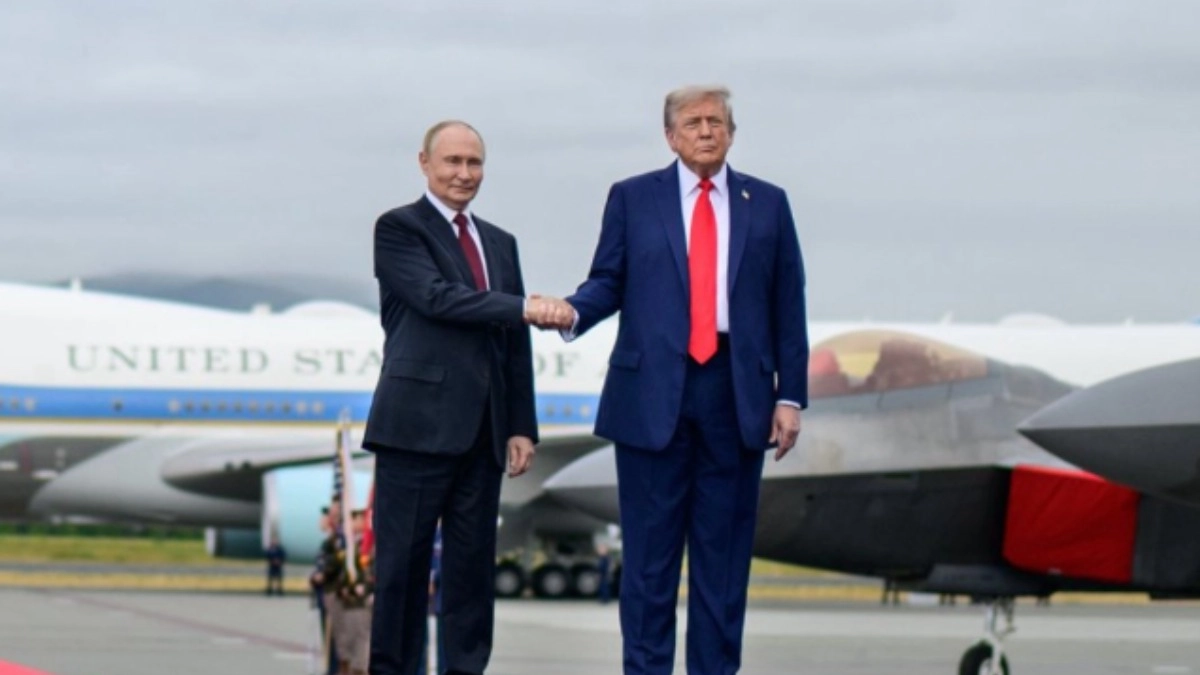
Trump-Putin Press Brief Ends With No Agreement After Alaska Summit | Image:
X
The images from Alaska tell the story Washington doesn’t want to admit: President Trump rolling out the red carpet for Vladimir Putin while simultaneously slapping punitive 50% tariffs on India, America’s largest democratic partner.
This isn’t just diplomatic incoherence; it’s a masterclass in how great powers can stumble their way into irrelevance.
Thursday’s summit at Joint Base Elmendorf-Richardson was meant to showcase Trump’s dealmaking prowess. Instead, it revealed the hollow nature of American leverage when wielded without strategic wisdom.
Putin got his opportunities, his F-22 flyovers, and his ride in the presidential limousine. What did America get? Vague promises of “understanding” while Russian missiles continued pounding Ukrainian cities during the very hours both leaders smiled for cameras.
The real winner wasn’t in that Alaska conference room, it was 8,000 miles away in New Delhi, where Indian policymakers watched American credibility crumble in real time.
The Tariff Trap: Punishing Friends, Rewarding Adversaries
Let’s address the elephant in the room: Trump’s decision to impose a crushing 50% tariff on $87 billion worth of Indian goods while treating Putin as an honoured guest represents perhaps the most strategically confused policy in modern American diplomacy.
The mathematics alone should embarrass any serious policymaker. India purchases 1.4 million barrels daily of Russian oil, roughly $42 billion annually at current prices.
The European Union, despite its loud sanctions rhetoric, still imports €35.9 billion worth of Russian goods, including record levels of liquefied natural gas. Yet somehow, it’s India that faces economic punishment for energy pragmatism.
Prof Dhruva Kumar, politician, educationist and geo-politics expert, comments, when Europeans can import Russian LNG to heat their homes, why can’t we import Russian crude to fuel our growth?” It’s a question Trump’s team seems incapable of answering convincingly.
The numbers reveal the deeper absurdity. Russia-India bilateral trade reached $68.7 billion in 2024-25, a six-fold increase from pre-pandemic levels. But this growth reflects market forces, not political alignment.
Indian refiners report Russian crude discounts have narrowed from $30 per barrel in 2022 to just $5 today, hardly the windfall Washington portrays.
China’s Quiet Victory
Here’s what should truly worry American strategists: Trump’s India policy is delivering Beijing exactly what it desires, a wedge between the world’s two largest democracies.
Recent signs of India-China rapprochement aren’t coincidental. Direct flights between Delhi and Shanghai resumed after a four-year suspension. Tibetan pilgrimage sites reopened to Indian visitors.
Prime Minister Modi is reportedly considering his first China visit in seven years for the Shanghai Cooperation Organisation summit.
None of this represents a fundamental realignment, but it signals India’s willingness to explore alternatives when faced with American economic coercion.
Beijing’s diplomats are surely noting that Trump’s 50% tariffs on India contrast sharply with his 19% rates for Pakistan, a country that’s increasingly integrated into China’s Belt and Road Initiative.
The Arctic Opening: Russia’s New Card
Buried beneath Alaska summit headlines lies a development with profound long-term implications: the acceleration of India-Russia Arctic cooperation.
Moscow has offered New Delhi icebreaker construction partnerships, sailor training programs, and Northern Sea Route access, potentially reducing shipping times to Europe by 40% while providing alternative energy supplies through Arctic LNG projects.
This isn’t just about oil; it’s about reshaping global trade flows independently of traditional Western-controlled routes.
What India Should Do Next
The path forward requires neither confrontation nor capitulation, but strategic patience combined with tactical flexibility.
First, accelerate Arctic cooperation while it enjoys tacit American acceptance post-Alaska summit. Icebreaker construction and Northern Sea Route development provide alternative supply chains, reducing traditional chokepoint vulnerabilities.
Second, leverage BRICS platforms to build economic alternatives without unnecessary provocation. Position India as the moderate voice preventing excessive de-dollarisation while creating practical options for sanctions-affected trade.
Third, continue defence diversification through indigenous production rather than complete supplier substitution. Frame this as supporting “Atmanirbhar Bharat” employment rather than geopolitical positioning.
Fourth, maintain measured increases in American energy imports while protecting Russian supply relationships through long-term contracts. Create accommodation optics without fundamental policy surrender.
Finally, strengthen third-country triangulation, particularly through UAE partnerships, enabling refined product exports to Europe using Russian crude inputs. This maintains commercial viability while reducing direct sanctions exposure.
The question isn’t whether India will bend to American pressure, but whether America will adapt to a multipolar world where middle powers chart independent courses. Thursday’s summit suggests the answer remains uncomfortably unclear for Washington.

